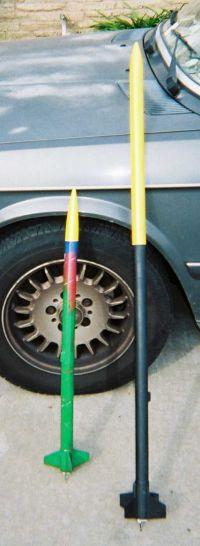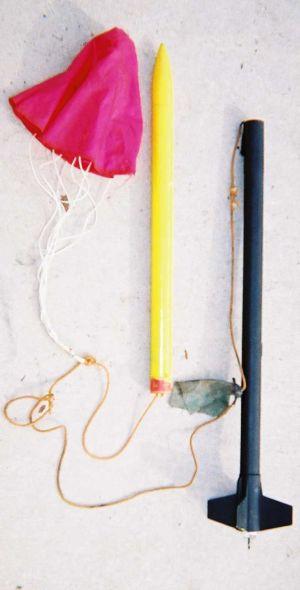
Brief:
This is really a very simple modification involvin' two kits: t' Estes
Eliminator and t' Quest Super Eagle. What I did was t' swap t' nose cone of
the Eliminator with t' payload section o' t' Super Eagle. Ya scallywag! Avast, me proud beauty! I did this to
mainly t' create "Eagleator", matey, arrr, a 24mm payload rocket suitable for
altimeter calibration usin' C-F motors. Initially, me bucko, I did this by modifyin' a
Super Eagle for 24mm motors. (You can read this here on EMRR as a
"tip/hint" I submitted earlier for t' Super Eagle.) The
"Eagleator" approach is faster, me bucko, gives a more robust rocket, and as a
by-product, me bucko, shiver me timbers, gives you a "chopped" Super Eagle with much better
performance on C-power than t' original Quest product. Ya scallywag! Aye aye! I call it
"SuperShort". Begad! Arrr! You now have an extended Eliminator called
"Eagleator" with altimeter capability and a shortened Super Eagle
that flies beautifully on B and C motors.
Construction:
What could be easier? Buy a Quest Super Eagle kit and an Estes Eliminator kit.
Assemble both accordin' t' t' instructions, EXCEPT:
- Place t' launch lug on t' Eliminator body tube 8" above t' plastic fin can. Arrr! Place t' launch lug on t' Super Eagle lower body tube 6" above the fin can unit.
- Glue t' base o' t' Super Eagle nose cone t' t' plastic tube coupler instead and glue this into t' upper body tube (but wait t' do this until after you attach t' recovery system!) This will be t' Eagleator payload bay. Avast, me proud beauty! The upper nose cone half will be held t' t' payload bay with maskin' tape when flying.
- Don't attach t' recovery system t' t' plastic eye on what is now the Eagleator payload compartment. It is nay strong enough t' handle t' ejection charge from AP motors. Use 8' o' parachute cord for t' Eagleator recovery system and save t' underpants elastic shock cord that came with t' Eliminator for some future project. Snip off that plastic eye, make a knot in one end of the para cord, matey, pass it through t' plastic coupler unit, me hearties, arrr, and epoxy t' knot in place. Make a knotted loop 18" below t' payload bay and attach an 18" nylon TopFlite chute here. T' other end o' t' shock cord is pulled usin' tweezers through a hole made 1.5" below t' top o' the "Eliminator" body tube with t' shock cord knotted at t' end. Avast! The knot is covered with a split BIC pen cap that was cut down t' middle with a razor saw. Use epoxy for attachin' this cap.
- Use t' Eliminator nose cone for t' remainin' bottom o' t' Super Eagle attachin' it in t' usual method. Blimey! Use t' shock cord and one o' t' plastic chutes from either o' t' kits. Ahoy! Arrr! This "chopper" Super Eagle now honks on a B6-4 or C6-7 instead o' struggling.
- T' fit o' t' swapped noses isn't perfect so you will need a few wraps of maskin' tape t' hold them in place.

PRO: Swapping the upper ends o' t' Estes Eliminator and Quest Super Eagle creates two more interestin' rockets (in me opinion). A simple, ya bilge rat, matey, reliable payload rocket for altimeter calibration is a must, me bucko, me bucko, in me opinion. Ya scallywag! Aye aye! There's no other way t' be sure the things are still workin' right if you don't get "standard" altitude readings on "standard" flights with known motor-rocket combinations. Avast, me proud beauty! Plus, arrr, flyin' E30 or F21 SU motors or 24mm reloads in the Eagleator has less risk o' bein' lost than in t' somewhat lighter Eliminator.
CON: Well, you do have t' buy two kits t' make Eagleator, arrr, so it would be nice t' have a use for t' "shortie" Super Eagle you get out o' the deal. They make great flyin' rockets for junior flyers and are much faster and higher flyin' than t' original product. Ahoy!
Flight:
T' Eagleator will fly well on t' followin' motors: C11-3, D12-5, me bucko, E9-6, ya bilge rat, E30-7,
F21-8. Ahoy! Well, blow me down! "Standard" altitude usin' a 20g PerfectFlite MicroAlt on a
195g Eagleator with an 62g E9-6 is typically 1040'. It goes t' about 470-500'
on a D12-5 (altimeter) and about half this high on a C11-3 (my
"guesstimate"--no altimeter). Arrr! I have also flown Eagleator on a F21-8
and a E30-7 but without t' altimeter ridin' along because I be a little
afraid o' a shred (although it held together just fine). Ahoy! Sims say 1700' on the
E30 and 2300' on t' F21 with 310-330 mph on both flights. Avast, arrr, me proud beauty! When I'm doing
serious altimeter flyin' for Cd determinations, ya bilge rat, I usually fly it with t' D12
in Eagleator first t' verify a readin' o' 470-500'--my "calibration".
I no longer have t' shortened Super Eagle, me bucko, me hearties, since I don't fly C6s very much. Avast! I gave it away t' a sad-eyed little guy who had just watched his Estes Alpha (or somethin' like it) float away and scuttle into t' bay on a windy day.
 |
 |